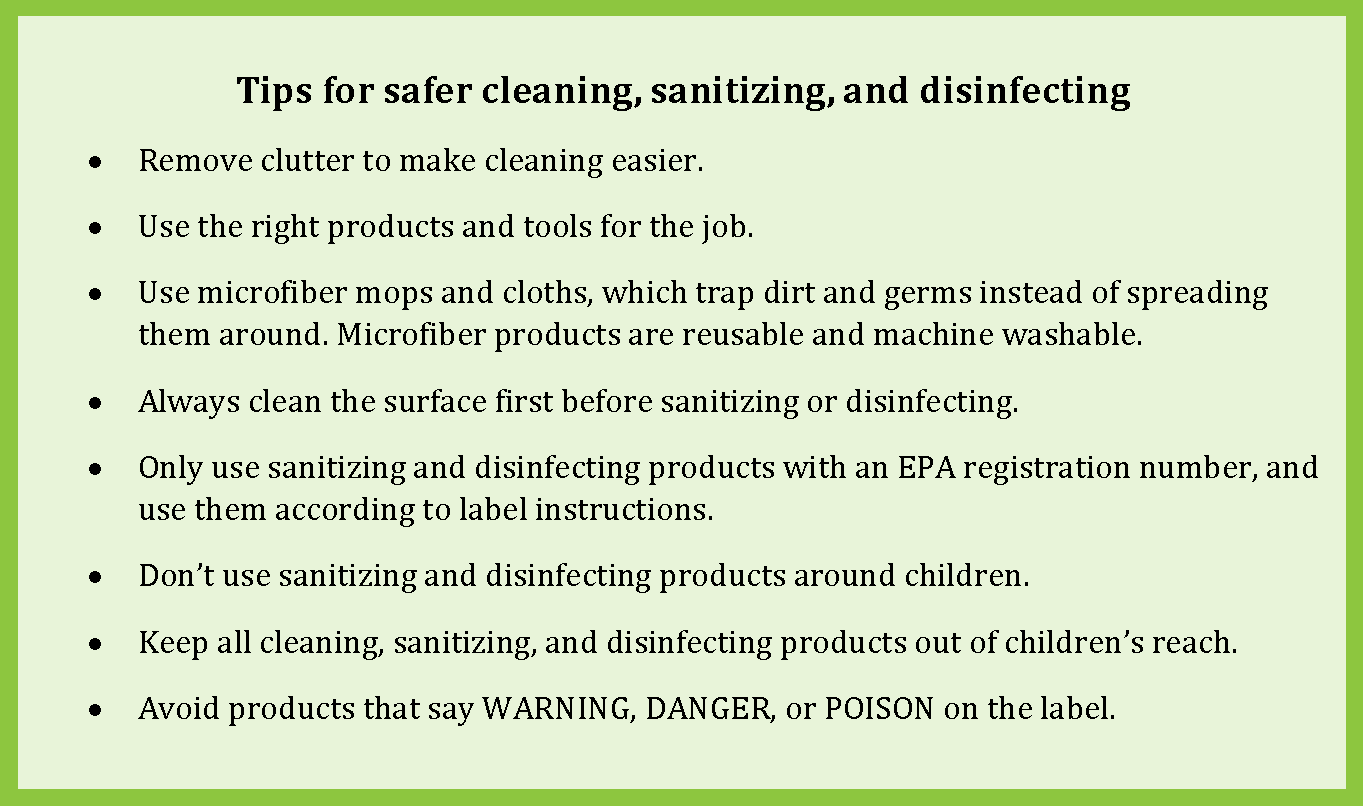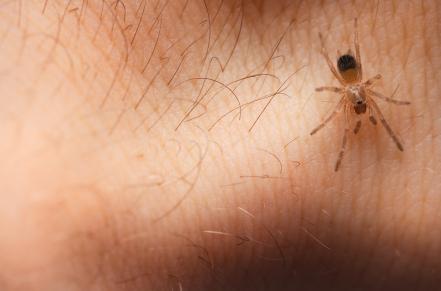Many cleaning and disinfecting products have chemicals that could be harmful. When cleaning your home or child care facility, it is safer to use products that do not cause harm to people and the environment. Products with safer ingredients are less likely to hurt your skin and eyes, cause chemical poisoning, or lead to breathing problems. Safer ingredients are gentler on clothes and don’t leave behind harmful residues. Keeping harsh chemicals out of our sewer systems also protects living things in our streams, rivers, and other waterways.
Young children are vulnerable
Young children play on the floor where chemicals can collect. They often put their hands and objects in their mouths and could swallow any chemicals that are left on them. They have softer, more absorbent skin, and their bodies have a harder time breaking down toxins. Young children are growing and developing and chemicals have a stronger effect on them. They breathe more per body weight than adults, and they have smaller airways. Vapors from chemicals can cause breathing problems, especially for children with asthma.
What is the difference between cleaning products and disinfecting products?
Cleaning products help to remove dirt, debris, and some germs from a surface. To clean: scrub, wash, or wipe a surface with the cleaning product, then rinse with water. Disinfecting products are meant to kill nearly all the germs (including bacteria and viruses) on a hard, non-porous surface like vinyl, stone, or tile. To disinfect: first clean the surface, and then apply the disinfectant. The disinfectant must stay wet on the clean surface in order to kill the germs. How long the surface must stay wet is called the contact time or dwell time.
How to choose safer products for cleaning:
Start by looking for a product with a UL ECOLOGO®, Green Seal®, or Safer Choice logo. Cleaning products with these logos meet standards to protect people’s health and the environment.
If you can’t find a product with one of these logos, choose a cleaning product without perfumes or dyes. Avoid cleaning products that claim to be anti-bacterial and products that spray fine mist out of a pressurized container.
How to choose safer products for disinfecting:
The EPA regulates products that kill germs (disinfectants). An Environmental Protection Agency (EPA) registration number on the label means the product will kill germs if used according to directions. The EPA’s Design for the Environment (DfE) is the only program that sets standards for disinfectants to protect people’s health and the environment. Germ killing products certified by DfE are:
- In the least hazardous toxicity group,
- Unlikely to cause cancer or hormonal problems,
- Unlikely to cause developmental or neurological problems.
To choose a safer disinfectant, look for the DfE logo:
If you can’t find a disinfectant with a DfE logo, look for a product with one of these less hazardous active ingredients on the label:
- Citric Acid
- Lactic Acid
- Hydrogen Peroxide
- Ethanol
Remember, disinfecting products with safer ingredients will still have an EPA number and must always be used according to label directions.
Limit the use of disinfectants
For most surfaces, cleaning will be enough. But sometimes you may need to apply a disinfectant after cleaning in order to kill germs, including viruses. This might be because of an illness outbreak, because a surface is soiled with blood or body fluids, or because the surface has been touched by many people (high-touch). Disinfectants are not meant for general cleaning.
What about food preparation surfaces?
Surface sanitizers are also germ killing products. They are mainly used in kitchens and on surfaces where food is prepared or served. Surface sanitizers kill bacteria but are not intended to kill viruses. The EPA also regulates surface sanitizers, so be sure to check for an EPA number on the label, and follow the directions for use. Sanitizers with the DfE logo are safer for people’s health and the environment.

Considerations for COVID-19
Early in the pandemic, many people were over-using and mis-using cleaning and disinfecting products because they were afraid they might get sick from touching a surface, and we didn’t fully understand how COVID-19 spreads. Now we know that COVID-19 mainly spreads person-to-person through the air. EPA’s List N has products to use against SARS-CoV-2 (the virus that causes COVID-19). You can visit the EPA website to search for DfE certified products that are also on List N. Check the box “Disinfectants for Use Against the Coronavirus SARS-CoV-2” on the DfE webpage to find a less toxic disinfecting product. Always read the label to make sure you are using a product safely.
Resources:
California Childcare Health Program/Department of Pesticide Regulation Step-by-Step Posters on Cleaning, Sanitizing, and Disinfecting in Child Care Programs
Environmental Protection Agency, DfE Certified Disinfectants
Caring for Our Children National Health and Safety Performance Standards, Appendix K
Pediatric Environmental Health Specialty Unit, Green Cleaning, Sanitizing and Disinfecting: A Toolkit for Early Care and Education
December 2021, UCSF California Childcare Health Program
This article was made possible with funding from the UCSF Chancellor's Fund.







